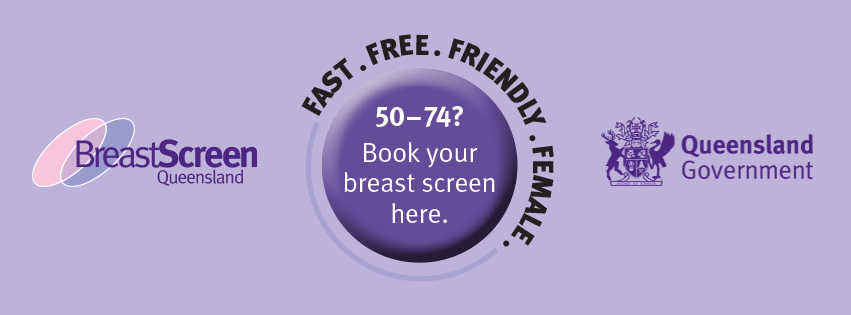
It’s easy to find a million things you’d rather do than go for a health check, and just as easy to come up with reasons why that health check isn’t really necessary.
But, to put it bluntly, women can’t afford to skip breast screens. Queensland women have a one in eight chance of being diagnosed with breast cancer by the age of 85 and over 75 per cent of breast cancers are detected in women over 50.
A breast screen every two years is strongly recommended for women aged between 50 and 74 as the evidence of benefit is strongest in this age group. Women aged 75 years and over are eligible to have a free breast screen and are encouraged to discuss the continuation of screening with their doctor, however they are not sent screening reminders.
Mammograms or breast screens are the most effective, proven method of detecting breast cancer early, providing greater treatment and management options. Screening is recommended regardless of whether there is a family history of breast cancer as nine out of 10 women diagnosed with breast cancer have no family history of the disease. Yet some women remain sceptical of the need to get screened, or find themselves putting it off.
Queenslander Julie Grey was one of those women. The 53-year-old admits that it took a lot of nagging from her friend Vicki before she went for a breast screen.
“I wasn’t too sure what would happen in the actual test,” recalls Julie. Her mother and sisters hadn’t been diagnosed with breast cancer and she wrongfully believed that meant she wasn’t at risk.
Julie says she was pleasantly surprised at how quick and easy she found the screening process.
“It was surprisingly quick,” she recalls. “It’s not like you’re sitting around for ages in the waiting room. I wasn’t, anyway. It was great. Just straight in, did the test and straight out. And you get the results pretty quick too.”
And there was no embarrassment and much less discomfort than she expected as well.
“They’re female radiographers so it wasn’t embarrassing or as painful as I thought it would be,” Julie says. “It’s only every two years and once you do it, you feel better,” Julie says.
Breast screens are conducted one-on-one with female health professionals, take just 30 minutes and can be booked online at breastscreen.qld.gov.au or by calling 13 20 50. No doctor’s referral is required.
BreastScreen Queensland doctor Deborah Pfeiffer says modern imaging techniques means that screening, which involves taking just two images of each breast, is much less uncomfortable than a mammogram was in the past.
“Most women find, if they haven’t had one before, it wasn’t as bad as they feared, or the newer techniques are better than they used to be,” Dr Pfeiffer says.
Concerns about exposure to radiation are another reason some women put off getting screened, but Dr Pfeiffer says that advances in imaging techniques means that’s an unnecessary worry.
“The fears of radiation are exaggerated,” Dr Pfeiffer says. “While there is a small dose of radiation involved, the risk of getting breast cancer from the total radiation exposure received by having a breast screen every two years is 1 in 10,000 compared to the risk of developing breast cancer from any cause, which is one in eight.”
To put the level of radiation used in perspective, the exposure during your mammogram is equivalent to six weeks exposure to natural radiation that exists in our environment.
Some women are scared that being screened may result in a terrifying diagnosis, but in fact, breast screening is designed to find cancer early before it becomes more serious.
“What screening does is bring forward the time at which breast cancer can be diagnosed, so that the cancer can be found when it’s small, confined to the breast and hasn’t spread to the lymph nodes,” Dr Pfeiffer explains.
The number of women being diagnosed with breast cancer continues to rise, with 18,087 women expected to be diagnosed in 2018. But with the help of early detection the mortality rate from breast cancer has dropped and the five-year survival rate has increased to 90 per cent.
“About seven per cent of women who have a breast screen will be asked to come back for further tests at assessment and around one in 10 women who return for assessment will need further specialist treatment because extra investigations are needed or because a breast cancer is found,” Dr Pfeiffer explains.
“Australia as a whole and Queensland as a whole are extremely well-served with our breast screening and assessment services and it’s a shame not to take advantage of these free accredited services where they exist because of fear or scepticism or mistrust,” she adds.
Julie, meanwhile, has gone from being a ‘screen procrastinator’ to getting hers done every two years right on the dot.
“Now I’m trying to convince my sister she has to go,” she says. “It’s something I’m prepared to be bossy about.”
IMPORTANT LEGAL INFO This article is of a general nature and FYI only, because it doesn’t take into account your personal health requirements or existing medical conditions. That means it’s not personalised health advice and shouldn’t be relied upon as if it is. Before making a health-related decision, you should work out if the info is appropriate for your situation and get professional medical advice.

A breast screen only takes 30 minutes and is a must every two years for women aged between 50 and 74.